The Distant Cousins: Renfe Series 250 electric locomotive by Roco
Afternoon all!
Our topic for this article shall be a locomotive which – while having been withdrawn from revenue service in reality – appealed to me sufficiently to claim modeller's freedom in order to justify procurement, and which also is, once again, illustrative of the multitude of influences Renfe embraced during its history.
Aiming to speed up replacing the older types of electric locomotives in service at the time and to obtain high-powered locomotives especially for heavy passenger and freight service, Renfe ordered – essentially in parallel – two separate batches of locomotives as the 1980s approached. Already covered in my earlier article "EF66's Big Sister," Mitsubishi, in conjunction with CAF and MACOSA as licensees, provided the thirty Series 251 locomotives as a derivative from the Japanese Class EF66.
With a similar operational profile in mind, Krauss-Maffei and a consortium of BBC, CAF and La Maquinista Terrestre y Marítima, or MTM for short, proposed a different twelve-wheel mixed traffic electric locomotive which technically can be understood to be distantly related to the Class 120 electric locomotives which at the time were in operational evaluation. Thirty were ordered initially.
 250-006 en via 3 de Sant Vicenç esperando via libre para salir hacia Tarragona. by enric436, on Flickr
250-006 en via 3 de Sant Vicenç esperando via libre para salir hacia Tarragona. by enric436, on Flickr
 Papelero en La Gornal by javier-lopez, on Flickr
Papelero en La Gornal by javier-lopez, on Flickr
 Papelero en Fayón by javier-lopez, on Flickr
Papelero en Fayón by javier-lopez, on Flickr
With the first five of these locomotives, designated Series 250, having been built in Germany and the rest in Spain proper, they were introduced beginning in 1982 and lasting into 1985. As originally configured, they utilised rheostatic power regulation, though a second batch of five 250s – designated Series 250.600 – with thyristor choppers was introduced in 1986, with introduction lasting into 1988. Owing to their significantly different traction control equipment, the 250.600s went through a lengthy operational evaluation phase but were found to not offer sufficiently significant advantages to warrant any additional procurement.
The 250s were originally allocated to the Can Tunis depot in Barcelona, and put to work on both passenger and heavy freight services. Originally designed for a maximum speed of 160 kph, they were restricted to 140 kph in 1988 due to their six-wheel bogies having been found to cause excessive roadbed wear at high speed. However, they were also cleared for working Talgo services at that time.
In the early 1990s, the entire class was relocated to the Fuente de San Luis depot in Valencia, and also soon displaced from passenger workings by the Series 252 locomotives which entered service at the time.
As the first decade of the 21st century ended, the class was put up for withdrawal as maintenance had been found to become increasingly laborious due to difficulty in obtaining spare components. The last revenue workings provided by 250s took place in late April, 2010.
It’s at this point that for my purposes, I would like to invoke artistic freedom and claim that, due to a solid economic upturn having generated a steady increase in rail freight traffic, Renfe had decided to reactivate those 250s it had found to still be in sufficiently good condition, and in fact to modernise these locomotives with thyristor choppers based on those of the 250.600s but incorporating necessary improvements. These refurbished 250s should, as per requirements for the reactivation programme, be fit to remain in service for at least an additional 15 years. While a number of 250s would have been needed to be broken down for spares and some had been found to no longer be in acceptable condition, 24 would have been earmarked for refurbishment.
As originally built, the technical specifications for the 250 could be said to begin with an all-welded, self-supporting body and running frame principally made of steel, with the body’s outline bearing some resemblance to that of the German 120, especially concerning the cab faces. The windscreen is split vertically into two panes, while five head and tail lights are provided on each cab face. The central upper headlight is, again, configured as a two-lens high intensity headlight. The bufferbeams carry standard UIC draw gear, buffers and brake pipes. As the 250s were originally outfitted for air and vacuum train brakes, they used to carry a vacuum brake pipe on each bufferbeam as well, which but was deleted when the last vacuum braked stock on the Spanish railways was phased out of revenue service by the mid-1990s. Access steps are provided on each end of the bufferbeams, as well as tread plates above each buffer, to permit safe access for shunting and maintenance staff. Furthermore, snow ploughs and ETS sockets are attached beneath the bufferbeams.
Internally, the body is divided into three sections, which would be the cabs and the engine room. The cab interior very closely followed German design practices, with the control desk being especially similar to the Unified Cab principle as originally implemented on the German Class 111 and 120 electrics. As the majority of the Spanish railway system is built for right hand running, except for the lines originally built and operated by the „Norte“ railway which continue left hand running, the cab is, as has long been standard for Spanish motive power, configured for the driver to be seated on the right. Access doors are provided on both sides and open into the cab spaces proper.
The locomotives are not outfitted for MU working and have the usual combination of vigilance control and the ASFA automatic warning system for safety.
The body flanks carry four engine room windows as well as twelve ventilation grilles per side, with eight of the grilles being offset towards Cab 1. The rooftop is split into three panels, with the centre panel carrying two box-shaped, rectangular fairings for the braking rheostat ventilation. The single arm pantographs, which are the common Faiveley AM 18 derivative used on numerous Spanish electric locomotives, are set on the outer panels, with the knuckles facing inwards.
Power regulation on the basic Series 250 locomotives is made through rheostats and variable series/parallel connection of the double traction motors, while the 250.600s were factory-fitted with thyristor choppers.
Compressed air reservoirs and a pair of battery boxes are hung underneath the running frame between the bogies. As mentioned further above, vacuum braked freight stock was still widely spread when the 250 was introduced, so the locomotives were dually outfitted with one primary and one auxiliary compressor for the air brake and auxiliary pneumatic circuitry, as well as an ejector pump for the separate vacuum train brake.
The bogies are of a similar design to that used on the German 120s, but with three wheelsets which are held by single-sided lemniscate levers. Helical springs with auxiliary hydraulic dampers are installed at the open ends of the bearing levers to provide primary suspension, while Flexicoil springs, hidden from view by the solebars, provide secondary suspension. There also is one pair of horizontally attached yaw dampers per bogie while traction bars attaching to a pair of low-reaching bearings to the inside of the bogies are provided for force transmission.
As on the Japanese-designed Series 289, 269 and 251, the bogies are designed with one large central distribution gear and one large BBC-designed double traction motor each, with both motors, designated 6 EDO 8146, having two electrically separated rotors on one shaft. The distribution gears also were configured with two switchable ratios of 3.66:1 and 2.29:1 for freight and passenger service originally.
The locomotives are outfitted with double-sided tread brakes with indirect train brake and direct locomotive shunting brake controllers, acting on all wheelsets and blended with the rheostatic brake.
Technical characteristics
Length, width and height – 20 m, 3.13 and 4.28 m
Wheel diamater – 1.25 m
Service weight – 124 tonnes for basic Series 250; 135 tonnes for 250.600
Configuration – C’C’
Power output – 4,600 kW
As for models of the 250, there are two choices in H0 scale: Vitrains and Roco. From what I know, either one seems to be a good choice, though I ended up deciding in favour of the Roco due to my experience with their models generally having been very good thus far.
Far as I was able to determine, there have been at least the following releases of Roco's model:
#62410A/B – 250-001 and 250-004 in original blue and yellow livery
#62412 – 250-601 in "Estrella" livery
#62418 – 250-013 in yellow and dark grey "Tracción" livery with older "Cargas Renfe" logo on cab sides
#62420 – 250-011 in yellow and dark grey "Tracción" livery with newer "Mercancías Renfe" logo on cab sides
#62422 – 250-603 in "Estrella" livery
I elected to obtain #62420 as I thought this variant would most closely match the appearance of these locos if they had indeed been returned to revenue service in recent times.
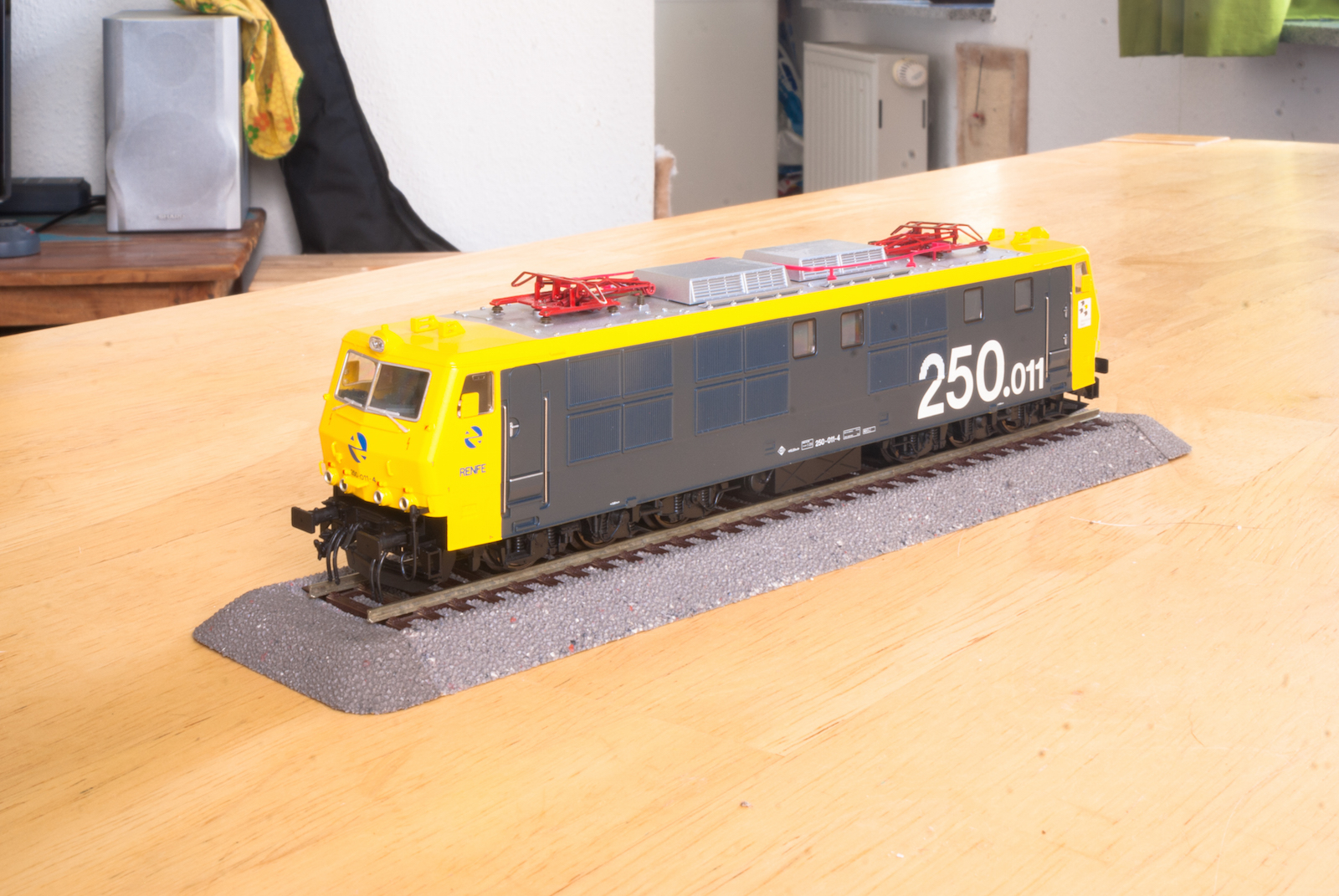
The 250's visual appearance as a whole is, to my mind, very much typical for the 1980s, and connoisseurs may indeed be able to spot the cues taken from the German Class 120 in the cab area in particular. Overall, the model gives an impression of high fidelity to detail, and is painted and lettered crisply.
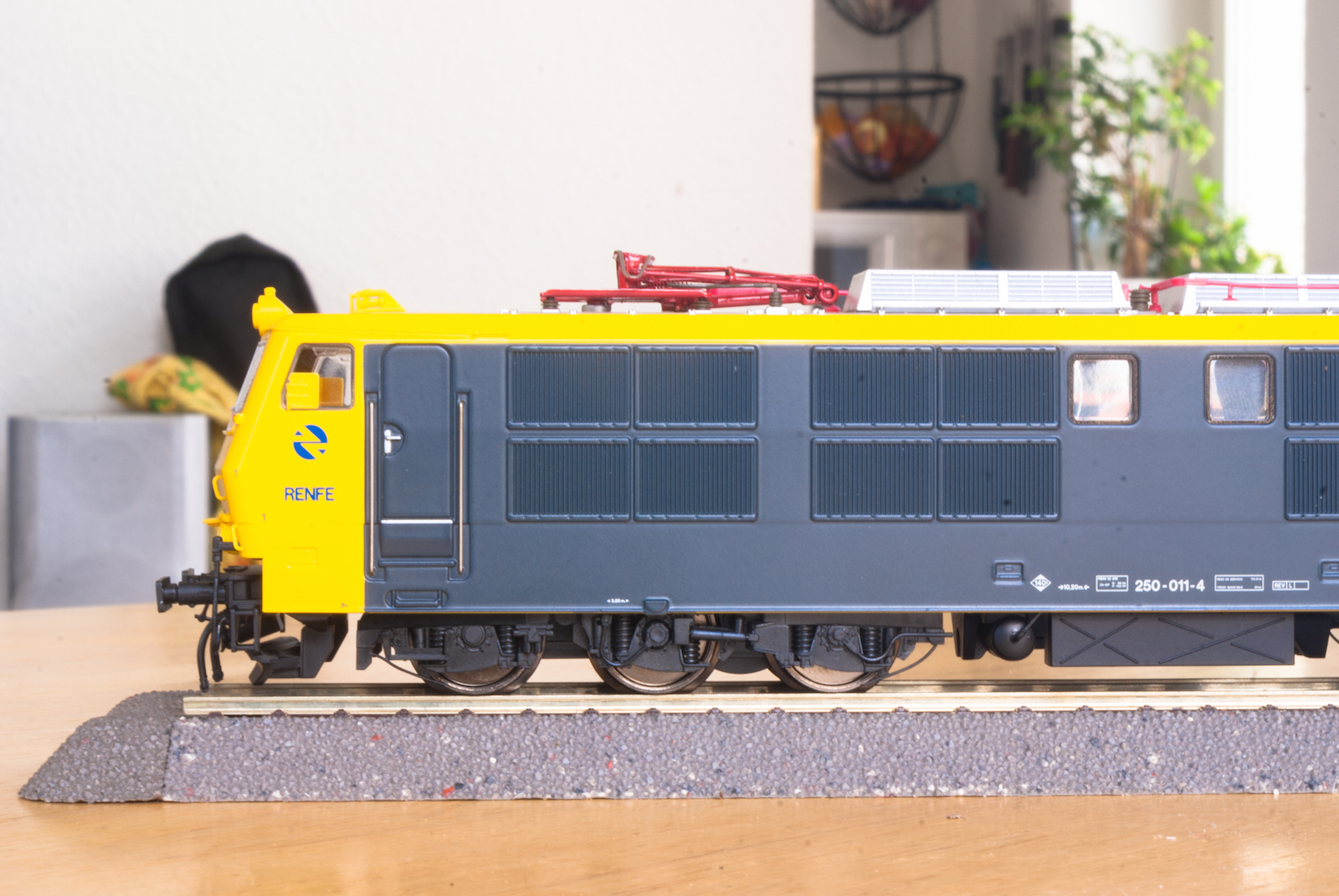
The add-on parts bag contains a full set of brake pipes and faux couplers, a pair of bufferbeams without cutouts for the coupler pockets, and another set of rear view mirrors in the "extended" position.
The technical lettering on the solebar next to the small running number comprises the following information, from left to right:
-
Maximum speed of 140 kph and clearance for speed range "A"
-
Distance between bogie pivots of 10.20 m
-
Braking data:
Charmilles brake valve with settings G and P
Braking weights of 84 tonnes on G and 132 tonnes on P
-
Service weight of 124.5 tonnes
-
Handbrake weight of 30 tonnes
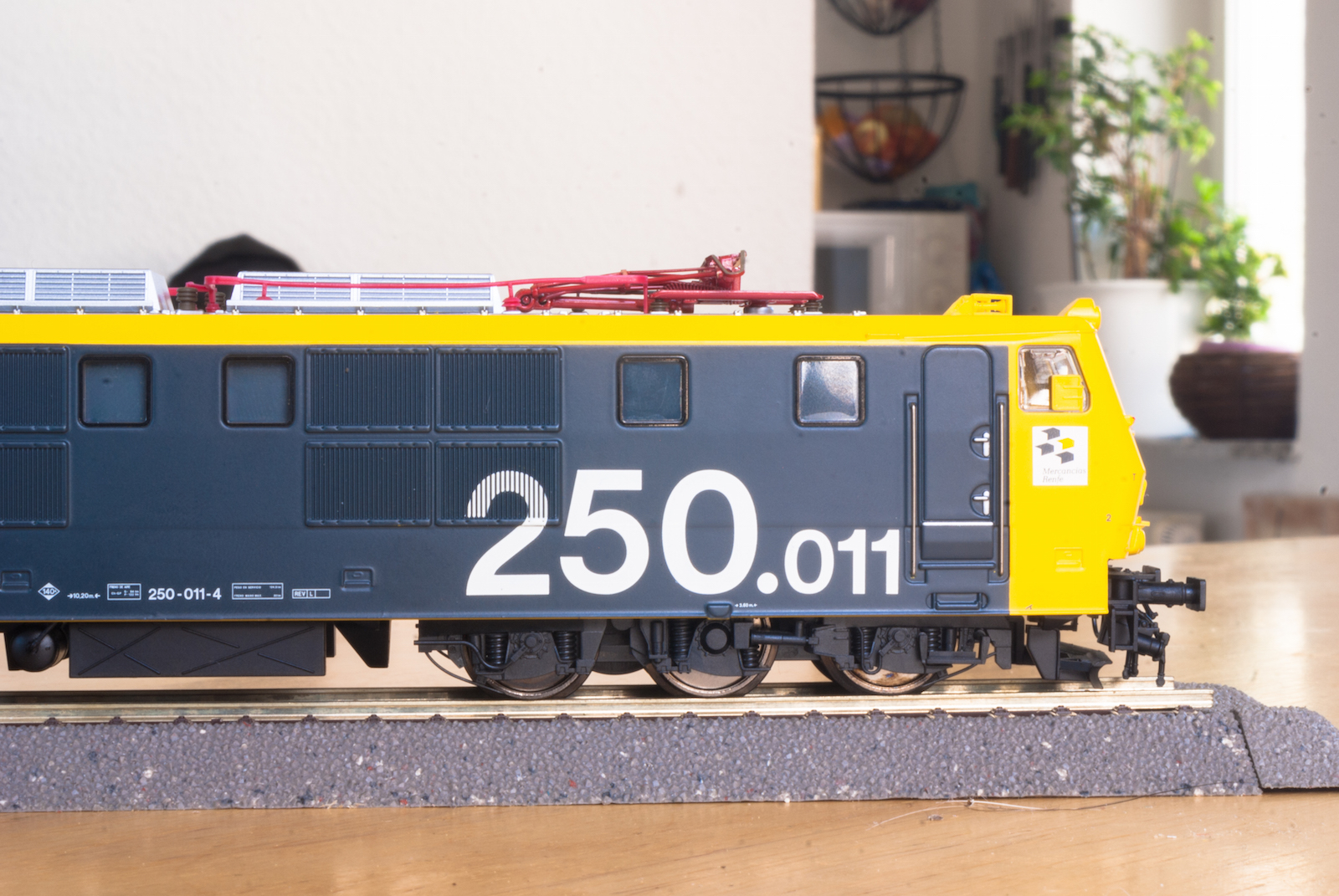
I suppose properly printing the billboard style running numbers across the ventilation grilles is a challenge in its own right but has, to my mind, been done just right. Note the "Mercancías Renfe" stickers on the right hand cab sides. The Mercancías sector as it exists today was, in fact, formed out of two predecessors: Cargas for general freight and Transporte Combinado.
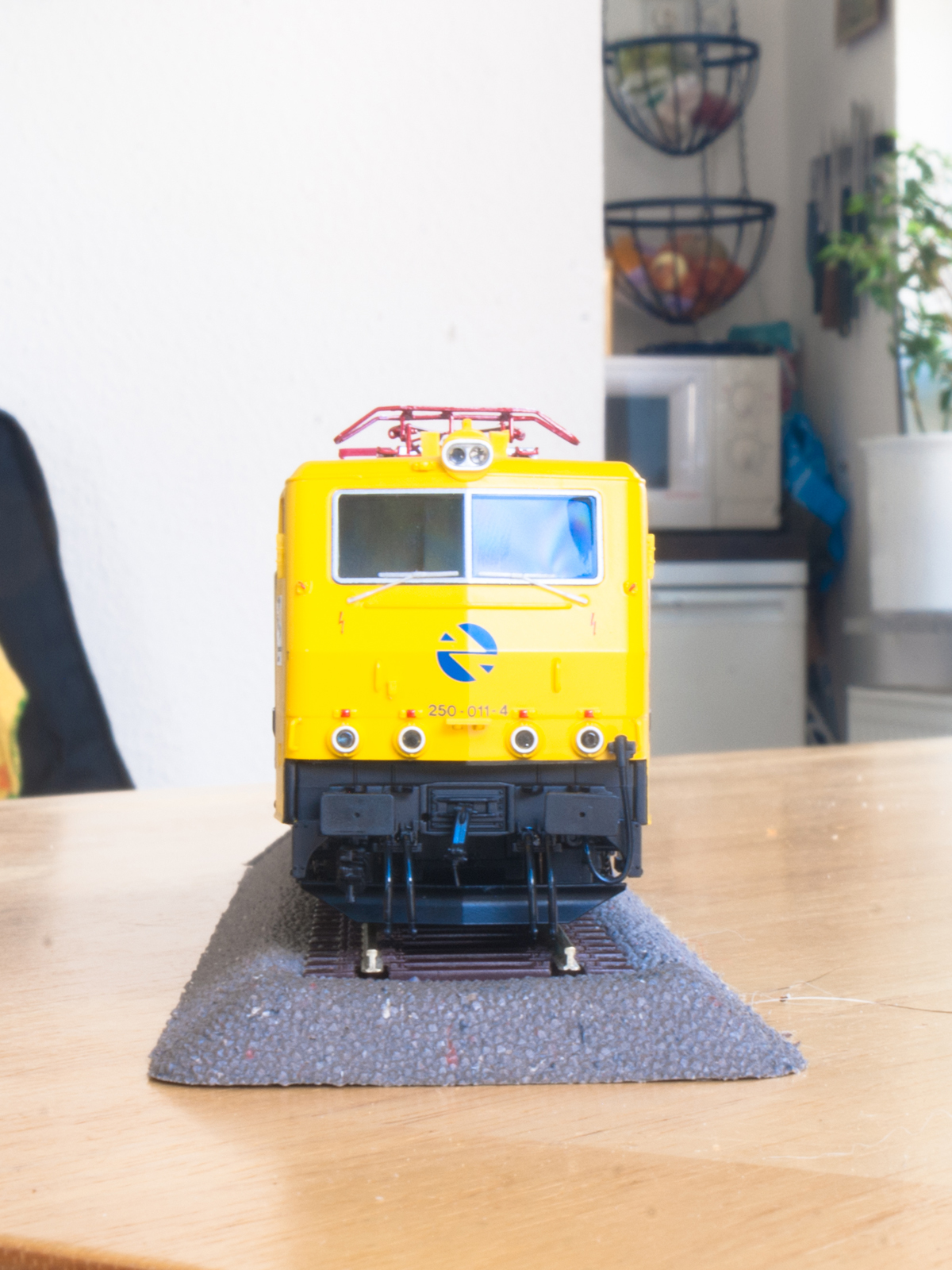
The headlight arrangement on the 250 is quite similar to that on the Japanese-built Series 289 and 269 which preceded the 250.
While the parts bag also contains a pair of vacuum brake pipes, I elected not to attach these as in my imagination, the resurrected 250s would have had all possible remainders of the vacuum braking equipment removed.
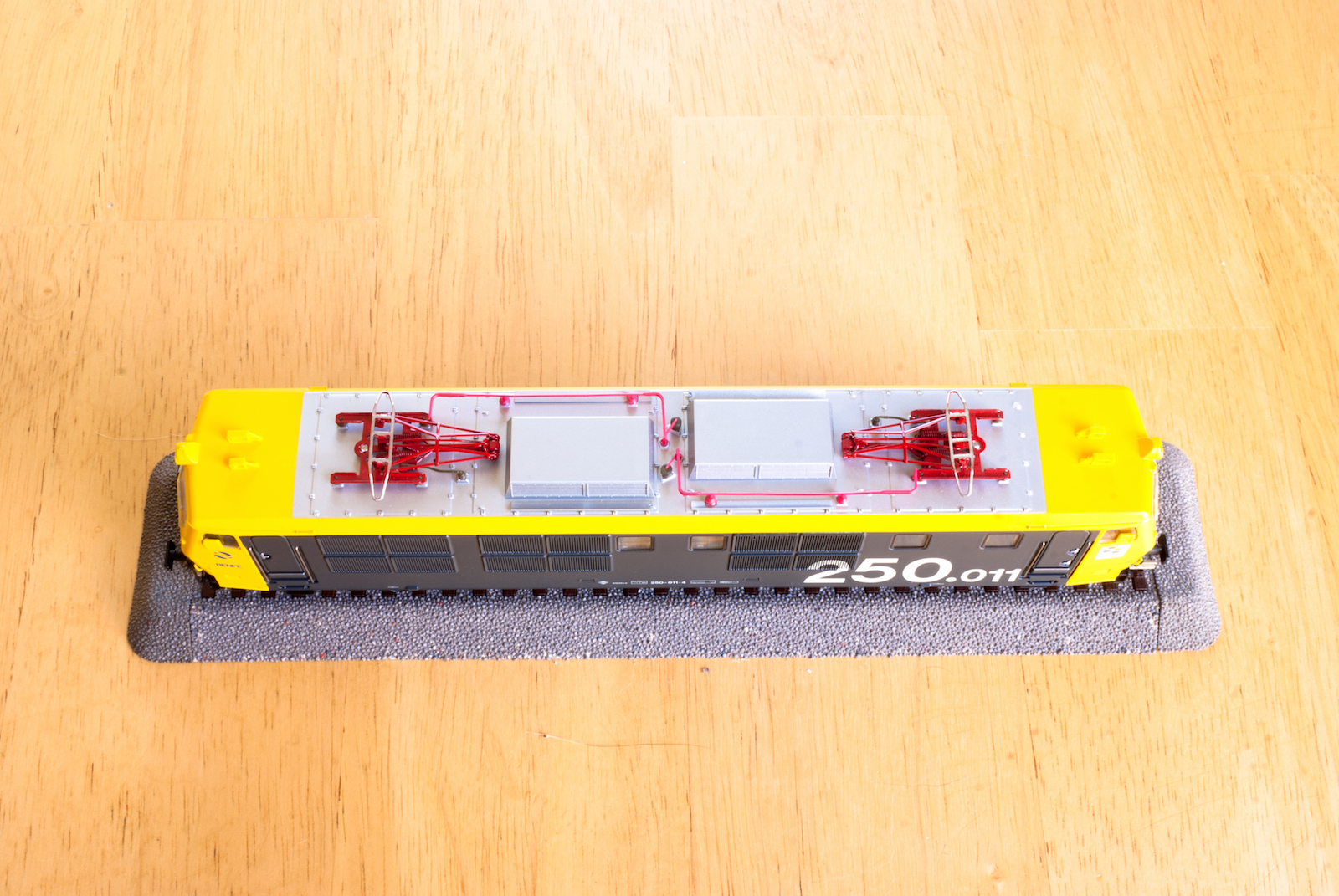
The top-down view reveals the arrangement of four independently removable roof panels, with the rooftop equipment being remarkably symmetrical. Note how each pantograph has its own busbar, with the busbars not being physically connected across the entire length of the roof.
Together with the frontal view, this image also illustrates how the horns are installed with a protective fairing ahead of their openings.
And for the usual closing note, a triple of Youtube videos with 250s hard at work:
Thank you for reading!
-
 2
2




2 Comments
Recommended Comments
Create an account or sign in to comment
You need to be a member in order to leave a comment
Create an account
Sign up for a new account in our community. It's easy!
Register a new accountSign in
Already have an account? Sign in here.
Sign In Now